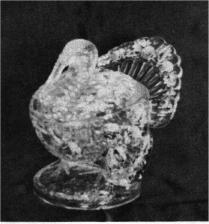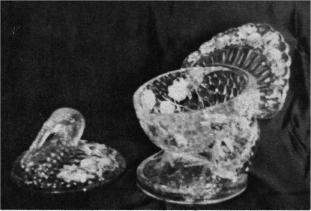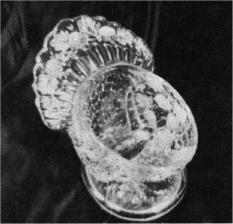Thanksgiving Turkey
By Doris Issacs
Issue No. 79 - November 1979
More on the "Turkey Bird"! While in Ohio in July, I regretfully had
to tell a friend that we have no evidence that the Cambridge Glass
Company made the clear Turkey she had purchased as "Cambridge".
 Most of you are probably familiar with the turkey she had purchased. It is
about half the size of the Cambridge #1222 Turkey, and was probably
made by the L. E. Smith Glass Company.
Most of you are probably familiar with the turkey she had purchased. It is
about half the size of the Cambridge #1222 Turkey, and was probably
made by the L. E. Smith Glass Company.
There have been several articles in the CRYSTAL BALL showing us ways to identify the real Cambridge turkey. I would like to call your attention to these articles once again, and urge you to study them before buying! These articles appeared in the following issues: Issue #10 - February, 1974 by Charles Upton; Issue #38 - June, 1976 by Jack & Sue Rettig; Issue #44 - December, 1976 by Dave Rankin; and you will also find a very good picture in the 1930-34 Catalog Reprint on page J.
I will attempt to add to the information in these articles by sharing the photos shown on this page, of our #1222 Turkey. It is crystal with the Charleston type decoration. I have seen these turkeys in amber, royal blue and blue bell colors, but this is the first one in crystal. The decoration contains berries and leaves. We are still debating whether they are strawberries or raspberries! The berries are almost a white to deep purple and the leaves are white to green in shading. Much bright gold is used and the head and feet show much detail. The head and feet are painted purple, with gold eyes, beak and toenails.

 The front of the tail has two rows of 17 feathers each, with spine
center. The back of the tail is smooth with no detail. The rump between
the wings has several rows of feathers with a row of leaves and grass
under the last row of feathers. The breast has nine rows of feathers.
The top of the tail, center to breast, center measures 9". The overall
height is 8", and the base is an oval 5-11/16" x 4-3/4". The lid
measures 6-1/4" (from center back to front) including 1/4" end where it
extends past the rim that fits inside the base. The second row of
feathers at the breast center has a center feather extending the length
of three rows of feathers, with several lines running the entire length
of this feather. The underside of the base has a rough, rippled
texture. It IS NOT crosshatched!
The front of the tail has two rows of 17 feathers each, with spine
center. The back of the tail is smooth with no detail. The rump between
the wings has several rows of feathers with a row of leaves and grass
under the last row of feathers. The breast has nine rows of feathers.
The top of the tail, center to breast, center measures 9". The overall
height is 8", and the base is an oval 5-11/16" x 4-3/4". The lid
measures 6-1/4" (from center back to front) including 1/4" end where it
extends past the rim that fits inside the base. The second row of
feathers at the breast center has a center feather extending the length
of three rows of feathers, with several lines running the entire length
of this feather. The underside of the base has a rough, rippled
texture. It IS NOT crosshatched!
I hope this helps put the right bird on your Thanksgiving table!
